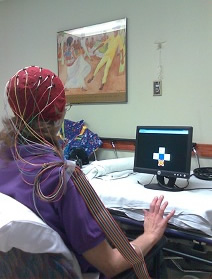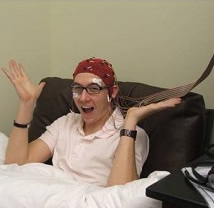Research Aims
Each year, over 1.5 million Americans are affected by Neuromuscular disorders. Afflicting both young and old, diseases such as amyotrophic lateral sclerosis, peripheral neuropathy, myasthenia gravis, and myopathies are debilitating, often progressive, and sometimes fatal. Weakness, paralysis, respiratory distress, and intractable pain caused by a nerve disease dramatically alter quality of life for both patients and families. Severely affected patients may lose entire voluntary muscle control and become completely locked in, unable to communicate in any way. A potential solution for restoring function to those with motor impairments is to provide the brain with a new, non-muscular communication pathway for conveying messages and commands to the external world. Our group is working on such a system, brain-computer interface (BCI), which monitors user's brain activity, extracts specific features from the brain signals that reflect the intent of the subject, and translates these features into actions —such as moving a wheelchair or selecting a letter from a virtual keyboard without involvement of any muscle or peripheral nerve. In the lab, we develop theoretical, computational frameworks and conduct experiments, to improve our knowledge of how the brain performs complex motor imagery tasks and how well our brain can interact with a machine.
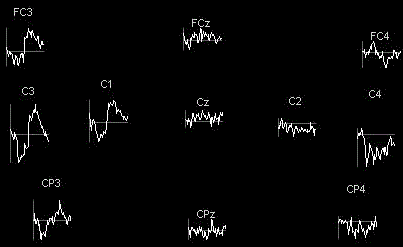
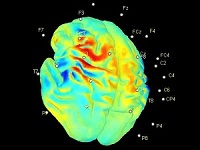 To further provide visual evidence for our hypothesis, EEG electrodes were pasted over the motor cortex while subject was performing right/left hand movement/motor imagery; 3-D head imaging for time sequence of ERD/ERS distribution over 10s was reconstructed using Matlab toolbox Brainstrom. The video illustrates power changes during right hand movement.
To further provide visual evidence for our hypothesis, EEG electrodes were pasted over the motor cortex while subject was performing right/left hand movement/motor imagery; 3-D head imaging for time sequence of ERD/ERS distribution over 10s was reconstructed using Matlab toolbox Brainstrom. The video illustrates power changes during right hand movement.
This study aims to explore whether human intentions to move or cease to move right and left hands can be decoded from spatiotemporal features in non-invasive EEG in order to control a discrete cursor movement in 2-D plane for a potential multidimensional brain–computer interface. The video on the right illustrates the experimental game.
The objective of this study is to develop a practical EEG-based BCI paradigm for continuous wheelchair control and perform the simulation of the wheelchair navigation in reaching different targets on four directions. Video on the left is the virtual wheelchair control on a computer screen.
Read More [poster]
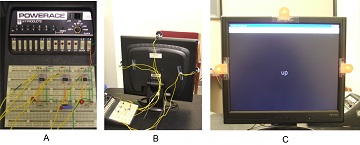 The study aims to enhance the universality of a 2-D BCI by combining two BCI systems, i.e., steady-state visual evoked potential (SSVEP)-based BCI and sensorimotor rhythm (SMR)-based BCI. The hybrid BCI system is expected to outperform a single BCI system.
The study aims to enhance the universality of a 2-D BCI by combining two BCI systems, i.e., steady-state visual evoked potential (SSVEP)-based BCI and sensorimotor rhythm (SMR)-based BCI. The hybrid BCI system is expected to outperform a single BCI system.
![]()
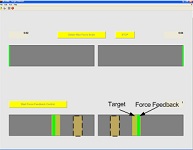 Corticomuscular coupling estimated by EEG-EMG coherence may reveal functional cortical driving of peripheral muscular activity.We attempted to study the time-course of corticomuscular connectivity under a dynamic visual target tracking task. A new device was developed for real-time measurement of dynamic force created by pinching thumb and index fingers.
Corticomuscular coupling estimated by EEG-EMG coherence may reveal functional cortical driving of peripheral muscular activity.We attempted to study the time-course of corticomuscular connectivity under a dynamic visual target tracking task. A new device was developed for real-time measurement of dynamic force created by pinching thumb and index fingers.
Read More [paper]
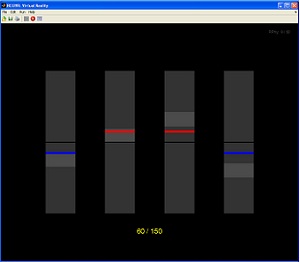 This study investigated human voluntary movement-associated cortical rhythmic changes following with a sensorimotor training program with cortical activity feedback. Statistical analysis on beta ERD/ERS in 5 subjects with both physical hand movement and motor imagery were performed to show the training effect.
This study investigated human voluntary movement-associated cortical rhythmic changes following with a sensorimotor training program with cortical activity feedback. Statistical analysis on beta ERD/ERS in 5 subjects with both physical hand movement and motor imagery were performed to show the training effect.
Planning and Execution of BCI Navigation with Uncertainty (Collaboration with HUST, China)
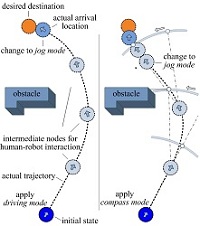 The cooperative method of human-robot system proposed in this study is based on three modes, according to robot intelligence level and user operation mode. Among them user switches to achieve movement and positioning control. To ensure the robot to achieve a continuous smooth movement, the control strategy that user makes decision based on predictive scene is studied. A fault-tolerant strategy is discussed. The effectiveness of the proposed method is evaluated by simulations.
The cooperative method of human-robot system proposed in this study is based on three modes, according to robot intelligence level and user operation mode. Among them user switches to achieve movement and positioning control. To ensure the robot to achieve a continuous smooth movement, the control strategy that user makes decision based on predictive scene is studied. A fault-tolerant strategy is discussed. The effectiveness of the proposed method is evaluated by simulations.

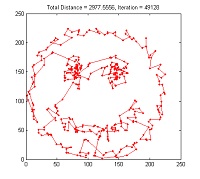 To solve this traveling salesman problem, original art work is converted to greyscale picture, represented with normalized spreaded dots. We apply Genetic Algorithm in finding the shortest route connecting all dots without multi visits at any one.
To solve this traveling salesman problem, original art work is converted to greyscale picture, represented with normalized spreaded dots. We apply Genetic Algorithm in finding the shortest route connecting all dots without multi visits at any one.
Read More [blog]
Thank you our "happy" subjects for your cooperation in the studies!!!
